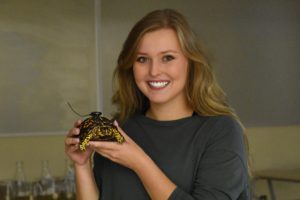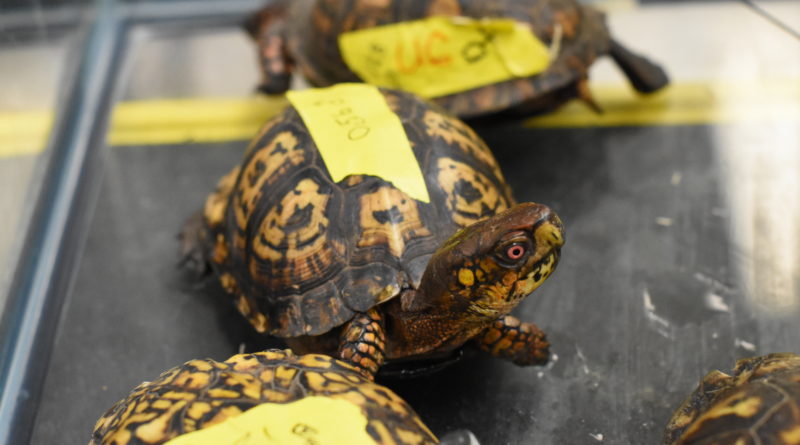Recent research into the Maryville College Woods box turtle population

If you happen to be taking a walk in the Maryville College woods at the right time, you can see a dozen or so enthusiastic students skimming the forest floor for box turtles. No, this isn’t for fun. It’s for science.
Four years ago Dr. Duncan, one chemistry professor on campus, decided he wanted to utilize the woods for his science-based FYS class. Having heard from Dr. Crain, a biology professor on campus, that there were a lot of turtles in the woods, Dr. Duncan decided this was the perfect opportunity to get the freshman students outdoors and doing research.
The class quickly realized there was a somewhat healthy box turtle population in the woods. When Dr. Unger, wildlife biologist and ecology professor on campus, heard of this he soon realized the wood’s academic potential.
Over time, vague interest in marking the turtle population has grown into a fundamental ecology lab, several senior theses, and a further understanding in the overall health of the Maryville College Woods. Dr. Unger utilizes ecology lab time to teach students how to perform radio telemetry. It entails finding a turtle, gluing a small radio device on the back of the turtle’s shell in a position that won’t disturb their activity, then returning it back to its original location. Later, a receiver is used to tune into the specific turtle’s beeps as it gets louder until you find the turtle.
This is an essential skill for wildlife biologists. Once you have tracked down the turtle, you can record behaviors such as home range, diet, population dynamics etc. This technique is used to track all kinds of wildlife from cougars to birds.
Two senior theses have stemmed from this project including Valerie White (Class of ’18) and Sarah Gordon (Class of ’19). Valerie White spent 2 years researching the box turtles and developed a strong baseline knowledge of the population dynamics.
Since then, current senior Sarah Gordon has further pursued the subject and is finishing up her thesis on gender, size, body shape, and home range, the area in which an animal lives in moves, of twelve turtles from the woods. She is also collaborating with a local veterinarian to gather health profiles of the turtles from blood samples. She plans to pursue a career in veterinary sciences. In total, 132 turtles have been tagged with radio devices in the woods so far.
“According to the literature, there could be up to 600 turtles in the woods which is one of the denser populations in the United States,” said Dr. Unger.
The research going into box turtle population goes beyond Maryville College’s campus though. Reptile and amphibian populations are on a global decline and scientists around the world are beginning to recognize this problem. Engaging in this project allows Maryville College students to become actively involved in current global issues.
Box turtles are also an indicator species. This means that their presence is a strong suggestion that the forest is in a healthy condition because they are sensitive to disturbance. We have a very healthy box turtle population and therefore we have very healthy woods.
For future research, Dr. Unger says, “This project will last as long as I’m here if not longer. I’d like to pass it on to the next professor and continue it.” He hopes to begin gathering data on the turtles’ dietary relationship to English Ivy, a major invasive species in the college woods.

